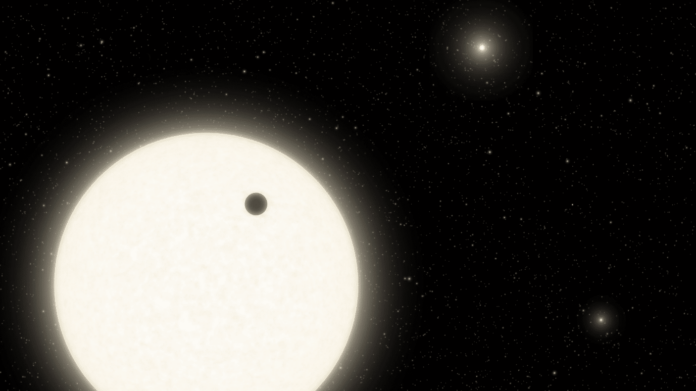
In the popular Netflix series, 3 Body Problem, viewers are introduced to a planet that boasts not one but three suns – which, by the way, proves to be more of a curse than a blessing. While the series is indeed purely fictional, the existence of planets with three suns is most definitely not.
Kepler Space Telescope
Back in 2009, the Kepler Space Telescope had just begun its search for planets beyond our solar system when it stumbled across a candidate planet that appeared to be part of a triple-star system. Due to the discovery of numerous other planets by Kepler in the following years, this particular candidate fell into relative obscurity. However, several years later, researchers could officially confirm: Kepler had discovered a planet with three suns.
TESS
Follow-up observations with the TESS Space Telescope confirmed the existence of KOI-5Ab and revealed it to be a gas giant approximately half the weight of our own Saturn. This planet orbits the star KOI-5A, which in turn is accompanied by two other stars: KOI-5B and KOI-5C. KOI-5A and -B take 30 days to revolve around each other, and KOI-5C orbits around KOI-5A and -B, taking 400 years to complete one round (see the illustration below).
Semi-chaotic existence
In the series 3 Body Problem, we can see that a planet with three suns has a rather tumultuous life, frequently facing a hefty dose of chaos. KOI-5Ab can somewhat relate to this. For example, observations reveal that KOI-5Ab doesn’t lie in the same plane as KOI-5B. This is quite peculiar since it is believed that stars and planets originate from the same disk of gas and dust. Researchers hypothesize that the somewhat deviant orbit of KOI-5Ab can be explained by a gravitational push from KOI-5B, that occurred while the planet was still forming. This push could have also reduced the distance between the planet and KOI-5A.
Notable observations
KOI-5Ab is far from being the only planet with three suns; several more have been discovered in the past decades. Furthermore, planets with two suns—which reminds us of Luke Skywalker’s homeworld in Star Wars—appear to be rather common. Most of the planets that researchers have discovered to date, however, still ‘simply’ have one mother star. But that doesn’t necessarily mean planets with two or three suns are rare. The majority of known planets only having a single mother star may be better explained by the fact that planets orbiting single stars are just easier to detect.











